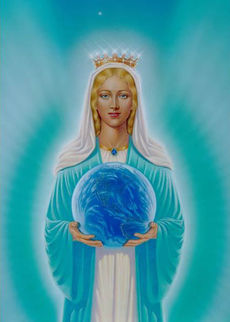Ave María
Un saludo que significa "Dios te salve, rayo madre"; una afirmación de alabanza a la llama Madre en cada parte de la vida.


la Palabra hablada
Cada vez que decimos el Ave María, estamos saludando al rayo Madre dentro de nuestro propio ser, a la energía, la luz blanca pura de Dios, que está enfocada en el chakra de la base de la columna vertebral.
Cuando decimos "Dios te salve, rayo madre", se activa ese campo de fuerza, y poco a poco, incremento a incremento, se eleva lentamente, de forma natural y en consonancia con las leyes de Dios, sin ser forzado y sin poner en peligro la evolución del alma.
Orígenes de la oración
La primera parte del Ave María es el saludo angelical de Gabriel, "Dios te salve, María, llena eres de gracia, el Señor es contigo". (Lucas 1:28.) A esto se añadió el saludo de Elizabeth a María: "Bendita tú eres entre todas las mujeres, y bendito el fruto de tu vientre". (Lucas 1:42)
La tercera parte del Ave María se inspiró en el Concilio de Éfeso en A. D . 470. La oración “Santa María, Madre de Dios, ruega por nosotros pecadores, ahora y en la hora de nuestra muerte”, zanjó la herejía nestoriana que surgió de la boca de Anastasio: “Nadie llame a María madre de Dios, porque María era un ser humano; y que Dios nazca de un ser humano es imposible ”. [1] Con esta afirmación adicional, el Concilio de Éfeso afirmó la Maternidad de Dios para toda la cristiandad.
The meaning of “Mother of God”
Mother Mary explained her calling as the Mother of God:
I AM a cosmic mother, and as much your mother as I am the mother of beloved Jesus. Some who are adherents of the Christian faith call me the Mother of God. To those of the protesting branch of orthodox Christianity this seems a sacrilege; for men may well ask, “Who is worthy to be the Mother of God?”
But this concept, when understood to mean the mother of the embodiment of the Divine Spirit, reveals the glorious truth that every mother who understands that which was spoken—“and the Word was made flesh and dwelt among us”[2]—may be the Mother of God.[3]
To mother means to give birth to, to give rise to, to care for, and to protect. Therefore, to be the mother of God is to give birth to, to give rise to, to care for, and to protect His Flame on earth. To mother the Flame of Spirit in the plane of Matter is the calling of the Feminine Ray in both man and woman.
Affirming our victory rather than our death
The third part of the Hail Mary succeeded in affirming the Motherhood of God; however, it also assigned to man the role of sinner and emphasized death as the end of the life of the sinner. Mother Mary has said that Keepers of the Flame ought not to affirm their sinful nature, but rather their rightful inheritance as sons and daughters of God; nor should they dwell upon the hour of death, but rather upon the hour of victory.
The Mother of Jesus therefore asked that we pray for her intercession “now and at the hour of our victory over sin, disease, and death,” thereby drawing their attention to the hour of victory over all conditions of time and space which her blessed Son proved in his life and in the hour of his victorious ascension. She affirmed the “hour of our victory” to be the eleventh hour when the greatest vigilance is required to countermand the backlash of the tail of the dragon depicted by Saint John the Revelator as being wroth with the Woman and going forth to make war with the remnant of Her Seed.
She promised to assist Keepers of the Flame, disciples of Christ, and devotees of the Mother Flame in winning their victory and the victory for all mankind if they would thus pray to her:
- Ave María, llena eres de gracia
- el Señor es contigo.
- Bendita tú eres entre todas las mujeres
- y bendito es el fruto de tu vientre, Jesús.
- Ave María, llena eres de gracia
- Santa María, Madre de Dios,
- ruega por nosotros, hijos e hijas de Dios,
- ahora y en la hora de nuestra victoria
- sobre el pecado, la enfermedad y la muerte.
Purpose of the Hail Mary
When we say, “Hail Mary!” we are greeting the Woman clothed with the Sun, the feminine principle of the Godhead, whom we know and love surely and above all in the beautiful Mother of Christ but who is also resident, though dormant, in man, in woman and as the light in our innermost being. The white sphere of the Mother is sealed in the sacral, or sacred, base chakra until we love her enough to magnetize her—to actually coax her to mount the spiral staircase and rendezvous with our souls in our very heart of hearts. Here in the Holy of holies, we recite the Hail Mary with her, we enthrone her as our beloved Mother, and she reunites us with the Trinity, the threefold flame of life. She takes us by the hand and leads us all the way to the summit of Being, the crown of crowns where God is All-in-all.
Mother Mary has assured us that the path of Kundalini yoga is indeed a part of Western tradition. And this is why she appeared to several of the saints with the safe and sound method of raising the Mother light through the rosary. This is why the saints have been portrayed with a white light upon their heads—because they have opened their crown chakras and entered into direct oneness with the I AM Presence. They have entered into the bliss of God.
Véase también
Para más información
Mark L. Prophet y Elizabeth Clare Prophet, El Mensaje De Maria Para La Nueva Era.
Fuentes
Elizabeth Clare Prophet, Inner Perspectives, chapters 50 and 55.
Elizabeth Clare Prophet, Mary’s Message for a New Day, preface.
Elizabeth Clare Prophet, Mary’s Message for a New Day, part 2, “Christian Prayer Forms and the Evolution of the Rosary.”
